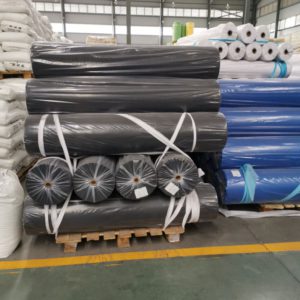PP spunbond fabric, also known as polypropylene spunbond fabric, is one type of nonwoven fabric that offers distinct characteristics and advantages compared to other nonwoven fabrics. Here’s a comparison of PP spunbond fabric with other commonly used nonwoven fabrics:
PP Spunbond Fabric vs. PP Meltblown Fabric:
Manufacturing Process: PP spunbond fabric is produced through a spunbond process, while PP meltblown fabric is manufactured using a meltblown process.
Fiber Diameter: PP spunbond fabric typically has larger fiber diameters compared to PP meltblown fabric.
Filtration Efficiency: PP meltblown fabric has excellent filtration properties due to its fine fibers, making it highly effective in capturing small particles. PP spunbond fabric has lower filtration efficiency but still provides adequate barrier properties.
Strength and Durability: PP spunbond fabric generally has higher tensile strength and durability compared to PP meltblown fabric.
Applications: PP meltblown fabric is commonly used in applications requiring high filtration efficiency, such as medical masks, respirators, and filters. PP spunbond fabric finds applications in various sectors, including hygiene products, agriculture, packaging, geotextiles, and furniture.
PP Spunbond Fabric vs. Needle-punched Nonwoven Fabric:
Manufacturing Process: PP spunbond fabric is produced through a spunbond process, whereas needle-punched nonwoven fabric is created by mechanically entangling fibers with needles.
Fiber Orientation: PP spunbond fabric has a more uniform and directional fiber orientation, while needle-punched nonwoven fabric has fibers oriented in multiple directions.
Strength and Stability: Needle-punched nonwoven fabric often exhibits higher strength and stability due to the entangled fiber structure, making it suitable for applications requiring high tensile strength and abrasion resistance.
Applications: PP spunbond fabric is widely used in disposable products, geotextiles, agriculture, and packaging, while needle-punched nonwoven fabric finds applications in automotive interiors, filtration, insulation, and geotextiles.
PP Spunbond Fabric vs. Spunlace Nonwoven Fabric:
Manufacturing Process: PP spunbond fabric is manufactured through a spunbond process, whereas spunlace nonwoven fabric is produced by entangling fibers using high-pressure water jets.
Softness and Drape: Spunlace nonwoven fabric tends to have a softer feel and better drape compared to PP spunbond fabric.
Absorbency: Spunlace nonwoven fabric typically exhibits higher absorbency due to its entangled fiber structure.
Applications: PP spunbond fabric is commonly used in hygiene products, agricultural covers, and packaging, while spunlace nonwoven fabric finds applications in wipes, medical products, and clothing.
It’s important to note that the specific properties and performance of nonwoven fabrics can vary based on factors such as the manufacturing process, PP Spunbond Fabric fiber composition, and post-treatment methods. Different nonwoven fabrics are designed to cater to specific applications and requirements, and the choice of fabric depends on the desired characteristics and intended use.
What are the different types of PP Spunbond Fabric available in the market?
In the market, there are various types of PP spunbond fabric available, each with its specific characteristics and applications. Here are some common types of PP spunbond fabric:
Standard PP Spunbond Fabric: This is the most commonly used type of PP spunbond fabric. It is made from polypropylene fibers that are spun and bonded together using heat and pressure. Standard PP spunbond fabric offers good strength, durability, and barrier properties. It finds applications in hygiene products (such as diapers and sanitary napkins), agriculture (crop covers and nursery bags), packaging, and furniture.
Hydrophilic PP Spunbond Fabric: Hydrophilic PP spunbond fabric is treated to enhance its liquid absorption and dispersion capabilities. It is designed to quickly absorb and distribute liquids across the fabric, making it suitable for applications such as topsheets in hygiene products, medical disposable products, and wipes.
Antistatic PP Spunbond Fabric: Antistatic PP spunbond fabric is treated with special additives to reduce or eliminate static electricity. It finds applications in environments where static discharge can create hazards or damage sensitive electronic equipment. Antistatic PP spunbond fabric is commonly used in cleanrooms, electronics manufacturing, and protective clothing.
Flame Retardant PP Spunbond Fabric: Flame retardant PP spunbond fabric is treated with flame retardant chemicals to reduce its flammability. It is used in applications where fire safety is crucial, such as protective clothing, upholstery, and automotive interiors.
UV Stabilized PP Spunbond Fabric: UV stabilized PP spunbond fabric is treated with additives that provide resistance to degradation caused by ultraviolet (UV) radiation from the sun. This type of fabric is commonly used in outdoor applications like agricultural covers, geotextiles, and furniture upholstery, where prolonged exposure to sunlight can lead to material degradation.
Colored PP Spunbond Fabric: PP spunbond fabric can be manufactured in various colors by adding pigments or dyes during the production process. Colored PP spunbond fabric is used for decorative purposes, branding, and applications where visual appeal or color coding is required.
These are some of the commonly available types of PP spunbond fabric in the market. The choice of fabric depends on the specific requirements of the application, such as strength, absorbency, flame resistance, UV resistance, or antistatic properties.
